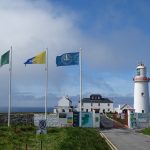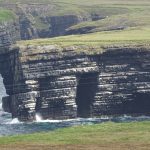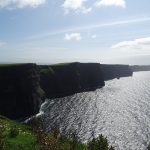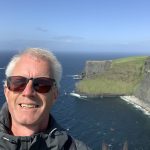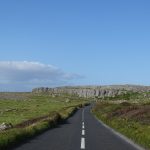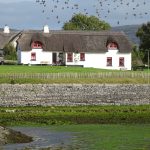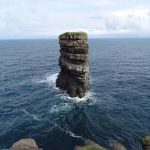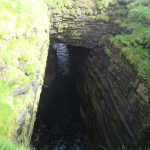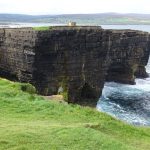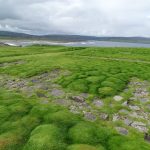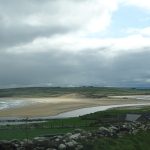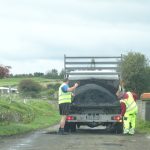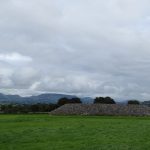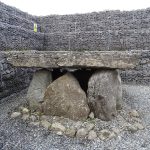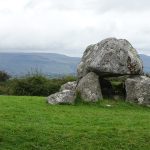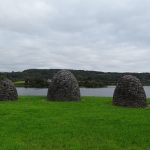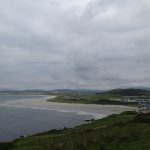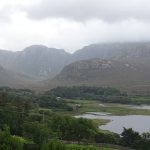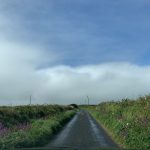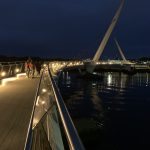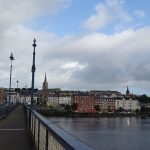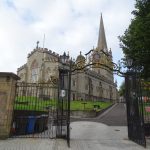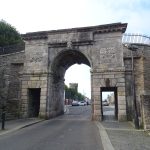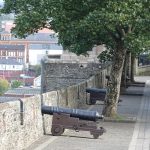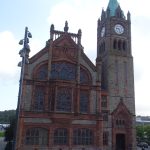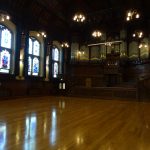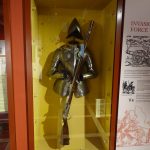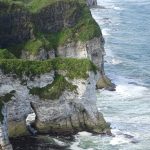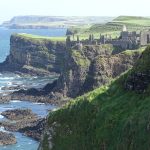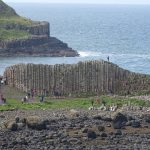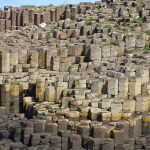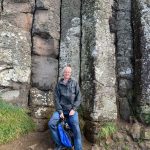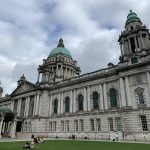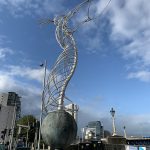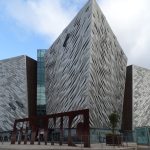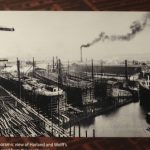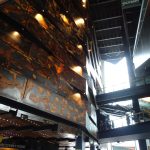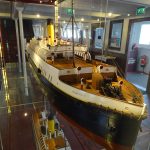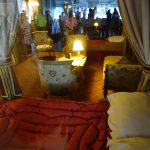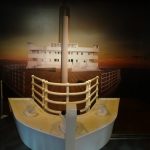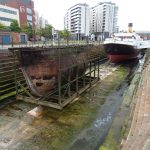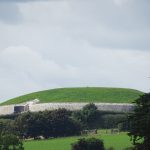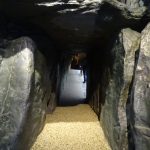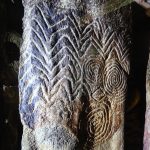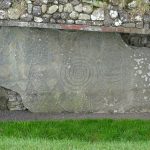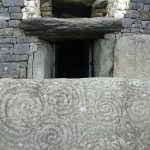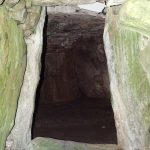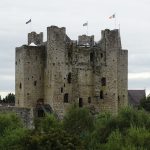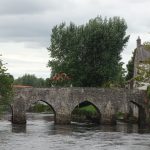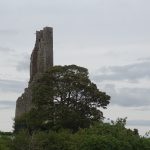Sunday August 27. It’s drizzling this morning and via Listowel we drive to Tarbert, where we take the ferry to the next peninsula. It is now dry and we look from the ferry to the coast on both sides. We follow the southern coast via the Wild Atlantic Way towards Kilkee. Over Blackweir Bridge on the coast road to Loop Head Lighthouse. The sun is shining and the white lighthouse pops out. Here we get a tour and a young man tells about the 4 families who lived here and took turns to wind up and keep the lighthouse going. The view from the house and the lighthouse are top notch. From the tower, the coastline with the rocky cliffs in the sun gives a nice picture. We follow the route to Kilkee and via Liscannor we arrive at a mega parking lot for the Cliffs of Moher. The wind is blowing strongly and along the cliffs there is a hiking trail with various viewpoints overlooking the sun-drenched cliffs. After lunch continue north along the coast. Via Fanore we drive through a landscape of rocks and barren gray mountains on the right and the ocean on the left. Brilliant again. We continue to follow the coast to Kinvirra and on the way we pass another village with Irish houses with thatched roofs.
On Monday it is suspiciously quiet on the road until around 12 o’clock. Later it turns out to be a Bank Holiday. Past Laugh Conn, a large lake, we head north to finally arrive at Downpatrick Head. Park and walk up to the cliff. Here we see the pinnacle in the water. Beautiful. More beautiful cliffs. Walking over the edge is quite scary given the height and the lack of a fence. There is a fence around the blowhole and light can be seen through the tunnel. Apparently still a long way inland. Furthermore, ‘EIRE’ was made here with stones, so that in the 2nd World War the Americans knew that it was Ireland and not Great Britain. Wouldn’t it be annoying if the bombs went off here already. The grassland on the cliffs is still quite marshy, despite being dry now. We continue the Wild Atlantic Way along the coast and see beautiful stretches of coast. At Carrowmore we visit the info center and the stone tombs from 5 to 3 thousand BC. Still interesting, although they are mainly stone circles. One grave is a reconstruction around the dolmen, so that you can clearly see what it was like. Continue along the coast, which is constantly changing. More to the north it becomes more and more rocky. On the coast several sandy beaches, with regular people on and in the sea. At Kellybegs, we visit the Beehive Little Cells, round piles of stones that form a hut. Continue north along the route and then take a shortcut to the east along the Clady River. Beautiful rugged landscape with rocky mountains and moors, the necessary streams and lakes. Via Letterkenny we take the N13 towards Londonderry and enter the city from the south. We missed the border with the UK, but under the speed sign it is neatly stated that it is in miles per hour, still a good hint. Check in at Iona Inn and then head into town for a bite to eat at Fritzroy’s. Just a bit through the city, through the old gate in the wall and to the central square, with the war memorial. Along the Guildhall over the Peace Bridge, a winding cable-stayed bridge for walkers.
Tuesday, breakfast at the inn. It takes some effort to understand the lady, but I can conclude that the question is coffee or tea. They call it coffee, but it is more like tea in terms of strength. The typical English breakfast is a hearty bite and quite greasy. A little bit of daylight in the city. We walk through the city, which slowly awakens. Past Saint Columb’s Cathedral, which is still closed, through one of the gates into the walled city. Past the Courthouse and up the wall at the Bishops Gate for a walk on the wall. It is possible to walk on the wall around the city. Still nice. From Double Bastion look with the cannons over the surrounding neighborhoods. We continue clockwise along the wall past Walker’s Plinth and St Augustine’s Church, round the corner and have a view of Guildhall. Here we leave the wall and take a look inside the Guildhall. Beautifully restored after the IRA bomb attack in 1972. Lots of woodwork and beautiful stained glass windows. Through the Shipquay Gate back into town and a visit to the Tower Museum. Here the history of the city is told. From prehistoric times to the present. The revolt against the British and Bloody Sunday, which took place a few hundred meters from here, should of course not be missed. Soon we follow the coastal route again. Now not the Wild Atlantic Way, but the Causeway Coastal Road. We pass villages like Portstewart and stop here and there for some snaps. Then onto Causeway Road. Park at the train station and hike up the cliff. We get a shower over us, but after 5 minutes it is dry again and the sun actually comes through. The view from above is beautiful. Then we take the Shepherd’s Path down to the coast. Follow the path further along the coast enjoying the view. A doorway on the path, but we are allowed through and just around the corner is the magnificent view of the Amphitheatre. Magnificent cliffs, black, green, red and with basalt formations. Back along the coast and along the Giant’s Causeway, a huge basalt formation, with legions of tourists arriving here by bus. Still very nice to see though. Then quietly along the coast back to the starting point and look for the car. Continue by car along the coast and found a cafe along the road for coffee with a cake. Via Ballycastle and Waterfoot to Larne. From the coast road, Scotland is faintly visible in the distance. Check into Belfast and head into the city.
The next morning a short ride to the Titanic Experience Center, that takes you back in time when the Titanic and other great boats were built. The construction site was huge and so was the boat. Lots of information and an attraction with trays that go through the construction along the construction site, as it were. More visualizations and then after a few hours we are outside again. We visit the SS Nomadic and see what life was like on this boat. This is located in an old dry dock, which is also interesting to see. Then we travel south and soon we are back in Ireland. At Drogheda we turn west into the interior. We follow the signs and make a huge detour, but eventually we arrive at our destination, Newgrange Visitors Center. Here we learn about prehistory. How people lived here and what they did 3200 BC. built. Then, after coffee, on the bus and a visit to Newgrange, a large round hill of stones with grass over it. The guide tells a hundred and we are taken past the large stones with figures on them. Unfortunately we can’t get in. A shame, but there is still plenty to see. Then back and by car around the river again and a visit to Dowth, where we walk around and can look inside at the entrances. Impressive that so long ago they brought these big stones, which weigh tons, over a great distance of about 50 km, and built these tunnel graves. Another short stop in Trim, where Braveheart Castle is located. That is, the ruin of it. The last stop today is Dublin. We walk along the river towards the Temple Bar area, where the pubs and restaurants are. En passant we pass some nice buildings and we settle down in the Beer Temple to try a local beer and have a bite to eat.

